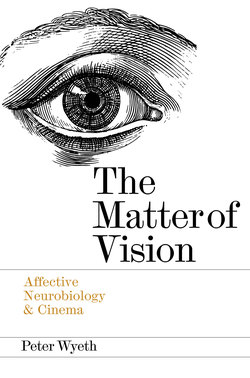Читать книгу The Matter of Vision - Peter Wyeth - Страница 8
На сайте Литреса книга снята с продажи.
LCR v VAE Vision
ОглавлениеThe starting-point of this enquiry was a sense that Cinema is more powerful than it is given credit for, and that power comes from its nature as a visual medium. The conception of Vision that accompanies that view sees it as the source of virtually all our knowledge about the World. Unlike Language, we do not in general have to practice Vision.15 With Language there is a search for every word, sometimes conscious, often unconscious or Automatic. With Vision we do it without thinking (even where we get it wrong first time around). There is immediately an irony in that situation in that we tend to take the power of Vision for granted. That might be thought of as the Tragedy of Vision.
Language is said to be around 40,000 years old, with recent estimates putting it as 100,000 years old, and speculation that it might be considerably older, even up to a million years old or more. Man is said to be around 2.4 million years old, depending on how you set the boundary between Man and his predecessors, but the first anatomically modern human fossils date back only 195,000 years, however primates with semantic communication seem possibly to predate ‘man’ which could set the origins of language further back.
Vision is eons older, evolutionarily, than Language. The notion that Cinema, a visual medium, could even be imagined to be ‘structured like a Language’,16 a relatively addition to the evolutionary scene, makes little sense (when added to the disparity in processing capacity). The reduction of Cinema to Language would be ahistorical in the extreme and Idealist in philosophical terms. From the perspective of evolution, Language can be argued on the contrary to be contingent upon Vision. For example, between two-thirds and three-quarters of words are said to represent Vision (or Sound, but with a much lesser number devoted to Sound). Language is a development that is based upon Vision.
One element of my interest in Vision was to look at the development of the eye. What could that tell us about Vision? The evolution of the eye can be traced fairly accurately and linked to certain geological changes on Earth. At the time in question the planet was covered with mist and geological changes raised the ambient temperature a few degrees, sufficient to disperse the mists. Before that, vision was useful but of only local significance. Afterwards, vision was at a premium, as the ability to see a potential predator, or indeed potential prey, obviously possessed biological value. Following these events, the eye accelerated in development over a relatively short period in biological terms, a period known as the ‘Cambrian explosion’, between 542 and 543 million years ago.17 By the end of that million year period, the sophistication of the eye was not much different from ours today.
The eye developed as the most efficient method of alerting creatures to a survival-threat. The reason for its efficiency is its capabilities in registering movement – as in the movement of a predator. Movement is the best sign as an early-warning of the approach of a threat to survival. Our eyes respond with alacrity to movement in peripheral vision, and that is an inheritance of evolution. It is, of course, also significant for Cinema, for moving-pictures.
